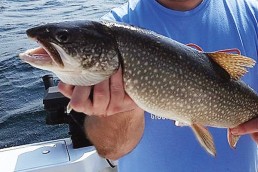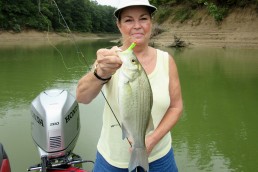Go High and Fast for Lake Trout
SHARE THIS POST
Fishing methods that catch lake trout in cold water
Lake trout have acquired the reputation of being slow-moving fish. The common belief is that to successfully catch lake trout you need a slow lure speed—very slow. Many lake trout anglers adhere to this slow lure speed as gospel. It is common practice to troll for lake trout at a speed of 1.5 mph. In fact, this is actually an effective trolling speed for lakers, when the fish are in deep water. However, lake trout aren’t in the extreme water depths year-round. Big bodies of water like Lake Michigan are slow to warm after a frigid winter. This article will tell you how to catch lake trout in those colder surface waters.
Lake trout are definitely a deep-water species, and reside in the depths because they prefer cold water. This cold water is favorable for the comfort of lake trout, but the deep water contributes to slow movement of the lake trout due to increased water pressure. The deeper the water, the more water pressure and density increases. If you have ever dove to the bottom of a deep swimming pool, it quickly becomes obvious that the movement of your body is dramatically slowed in the depths. Lake trout experience the same difficulty of movement, and the intense water pressure of the depths makes perfect sense for a slow lure retrieve.
Lakers on the surface
Surface water temperature is often near 50 degrees in June. With a surface water temperature that’s tuned into their comfort zone, these predators prowl for forage fish near the surface. Water pressure is dramatically less near the surface, so the slow movement of the extreme depths transform into speed up high in the water column.
The proximity of the lake trout to the lake surface varies, but it is not uncommon to see lake trout just a few feet deep during the early morning. I’ve witnessed them so close to the surface that their dorsal fins were in the air. This migration to the surface is linked to forage food. If the water temperature is adequately cool, lakers follow smelt and other forage fish wherever they go, including shallow water near shore. This near surface activity usually occurs for just an hour or two, and is more common on mornings when the lake is calm. As sunlight increases, the fish retreat into the deeper water, but with the colder water temperature, the lakers may only submerge to depths of 15 to 30 feet—and sometime less than that.
This near surface activity of the lake trout allows the angler to ignore the cannonball downriggers. Instead, flatlining can connect with the lake trout up high, and lead-core line easily reaches the trout that are 15 to 30 feet deep.
Line to focus on
The clarity of the water near the surface prompts using lighter line. Use monofilament in the 6- to 10-pound-test range for near surface trolling. Lighter line results in better, more lifelike lure movement. Anglers should consider using fluorocarbon line, which allows for a much more stealthy presentation of the lure. It definitely results in more hook-ups. If lead-core line is used, connect 75 to 100 feet of monofilament or fluorocarbon leader. This length attached to the lead-core line provides a more natural lure delivery.
Are you enjoying this post?
You can be among the first to get the latest info on where to go, what to use and how to use it!
Lake trout that are closer to the surface can certainly move a heck of a lot faster than their counterparts that are swimming a hundred feet below the surface. Trolling speed can be increased to 3 to 4 miles per hour. This increased trolling speed can prompt a chase reflex from lake trout. A faster moving lure mimics fleeing prey, and lake trout respond aggressively.
Put your steering arm to use when piloting the boat. Get out of the habit of prolonged periods of straight trolling. Do some slow serpentine turns, and then straighten the boat again. These turns create erratic lure speed, as the lure fluctuates from slower to faster or vice-versa during the turn. Serpentine turns definitely increase bites, so perform this maneuver often.
Mimic your common forage
When lake trout feed, these predatory fish are feeding machines. Mimic the most prominent size and color of the natural bait that are present. In Lake Michigan, emerald shiners and rainbow smelt are on the top of the food menu for lake trout. If an angler has a lure that resembles these favored forage fish, success is likely. For lure choice, smaller, slimmer silver spoons and stick baits in the 3- to 5-inch range are quite effective. Experiment with other colors and combos of colors. Combining blue and silver and green and silver colors has produced great results.
Dodgers and wobblers provide fish attracting flash, and create additional enticing movement to the lure attached. The lure is connected 18 to 24 inches from the pulsating dodger or wobbler with monofilament or fluorocarbon. The natural weight of the rig normally gets the lure into the 10-foot depth range when trolling at 3 to 4 mph. An inline swivel at the dodger or wobbler prevents line twist. Lake Michigan anglers have had success with some gaudy dodger colors, yet the standard silver and gold color is quite effective, especially with the wobbler. The time-tested wobbler has origins in the New England states and its use has caught on with a loyal following of Lake Michigan anglers.
Target the lake trout near the surface this season before the summer heat puts the fish down deep. Be sure to increase the trolling speed. You’ll be rewarded with a bent rod—and a net full of lake trout.
Finding your favorite fish on foreign lakes–check out our article on Finding Remote Saskatchewan Lake Trout.
MWO
SHARE THIS POST
Did you enjoy this post?
You can be among the first to get the latest info on where to go, what to use and how to use it!
John Murray
John Murray has a passion for the outdoors. A former professional fly tyer and fishing shop owner for more than a decade, John is a member of the NYS Outdoor Writers Association and is determined to share an acquired lifetime of knowledge to help everyone become proficient hunters and anglers.



